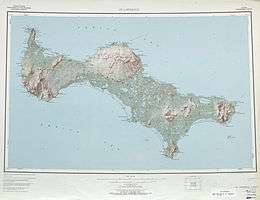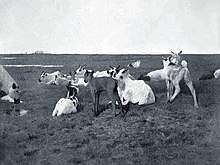St. Lawrence Island famine
The St. Lawrence Island famine killed around 1000 people on St. Lawrence Island in the Bering Sea off the Alaskan mainland during the years 1878–1880. Possible causes may have been overfishing, disease, or negative aspects of settler contact.
| St. Lawrence Island famine | |
|---|---|
 Map sheet of Saint Lawrence Island, Alaska | |
| Country | United States |
| Location | St. Lawrence Island, Alaska |
| Period | 1878–1880 |
| Total deaths | 1000~[1] |
| Consequences | Permanent change in the country's demographic, political and cultural landscape |

Background
In the late 19th century there were about 4,000 Central Alaskan Yupik and Siberian Yupik living in several villages on St. Lawrence Island. They subsisted by hunting walrus and whale and by fishing in the Bering Sea. A famine during the years 1878–1880 caused many to starve and many others to leave, drastically reducing the island's population. The revenue cutter USRC Thomas Corwin visited the island in 1880. After visiting multiple villages the Thomas Corwin's crew estimated that out of 1500 remaining inhabitants, 1000 were found dead of starvation.[1]
I landed at a place on the northern shore ... in which, wrapped in their fur blankets on the sleeping platforms lay about 25 dead bodies of adults ... Some miles to the eastward, along the coast was another village, where there were 200 dead people. In a large house were found about 15 bodies placed one upon another like cordwood.[2]
Survivors told of strange weather that prevented hunting and fishing in the ocean.[2] News reports of the time put the blame on traders supplying the people with liquor, causing them to "neglect laying up their usual supply of provisions".[3][4] Nearly all the remaining residents were Siberian Yupik. Other contributing factors were the excessive depletion and overfishing of ocean life, and the introduction of communicable diseases such as dysentery, measles, black tongue (anemia), scarlet fever, and vitaminosis.[5]
Many villages on the island were totally depopulated by the famine. One such village, Kukulik, was abandoned and was totally destroyed by the elements. All that remains of the once vibrant village is a midden mound 800 feet (240 m) long, 135 feet (41 m) wide and up to 23 feet (7.0 m) high, the largest known kitchen midden in the Arctic.[6] Other populations of the area experienced similar food shortages.[2]
Aftermath
Reindeer were introduced on the island on July 23, 1900, by Presbyterian missionary Sheldon Jackson in an attempt to prevent starvation and improve the Native Alaskans' "plight".[7][8][9] The reindeer herd grew to about 10,000 animals by 1917 but has since declined. Reindeer are herded as a source of subsistence meat to this day.[9]
President Theodore Roosevelt established a reindeer reserve on the island in 1903.[8] This caused legal issues in the indigenous land claim process to acquire surface and subsurface rights to their land under the section 19 of Alaska Native Claims Settlement Act (ANCSA), as they had to prove that the reindeer reserve was set up to support the indigenous people rather than to protect the reindeer themselves.[9]
See also
Bibliography
Notes
- Crowell & Oozevaseuk 2006, pp. 1–19
- Bockstoce 2009, p. 318
- The Cornishman 1880, p. 3
- The New Bloomfield 1880, p. 4
- Crawford 2001, p. 44
- Collins 1951, pp. 248–260
- Theberge & Theberge 2011, p. 143
- Government of Alaska 2018
- Case & Voluck 2012, p. 88
References
- Bockstoce, John R. (2009). Furs and Frontiers In the Far North: The Contest Among Native and Foreign Nations for the Bering Strait Fur Trade. Yale University Press. ISBN 9780300154900.CS1 maint: ref=harv (link) - Total pages: 495
- Case, David S.; Voluck, David A. (2012). Alaska Natives and American Laws: Third Edition. University of Alaska Press. ISBN 9781602231764.CS1 maint: ref=harv (link) - Total pages: 520
- Collins, Henry B. Jr. (1951). Encyclopedia Arctica 12: Alaska, Geography and General. XII. Trustees of Dartmouth College. pp. 248–260.CS1 maint: ref=harv (link)
- The Cornishman (11 November 1880). "A Starving Population". The Cornishman.CS1 maint: ref=harv (link)
- Crawford, Michael Hewson (2001). The Origins of Native Americans: Evidence from Anthropological Genetics. Cambridge University Press. ISBN 9780521004107.CS1 maint: ref=harv (link) - Total pages: 330
- Crowell, AL; Oozevaseuk, E. (2006). "The St. Lawrence Island famine and epidemic, 1878–80: a Yupik narrative in cultural and historical context". Arctic Anthropology. 43 (1): 1–19. doi:10.1353/arc.2011.0105. ISSN 1933-8139. PMID 21847843.CS1 maint: ref=harv (link)
- Government of Alaska (2018). "History". Government of Alaska. Retrieved December 16, 2018.CS1 maint: ref=harv (link)
- Theberge, Mary T.; Theberge, John B. (2011). The Ptarmigan's Dilemma: An Ecological Exploration Into the Mysteries of Life (2011 ed.). McClelland & Stewart. ISBN 9780771085185.CS1 maint: ref=harv (link) - Total pages: 416
- The New Bloomfield (October 19, 1880). "Five Hundred Deaths From Starvation". The New Bloomfield. ISSN 2327-6894. OCLC 21170413. Retrieved December 8, 2018.CS1 maint: ref=harv (link)